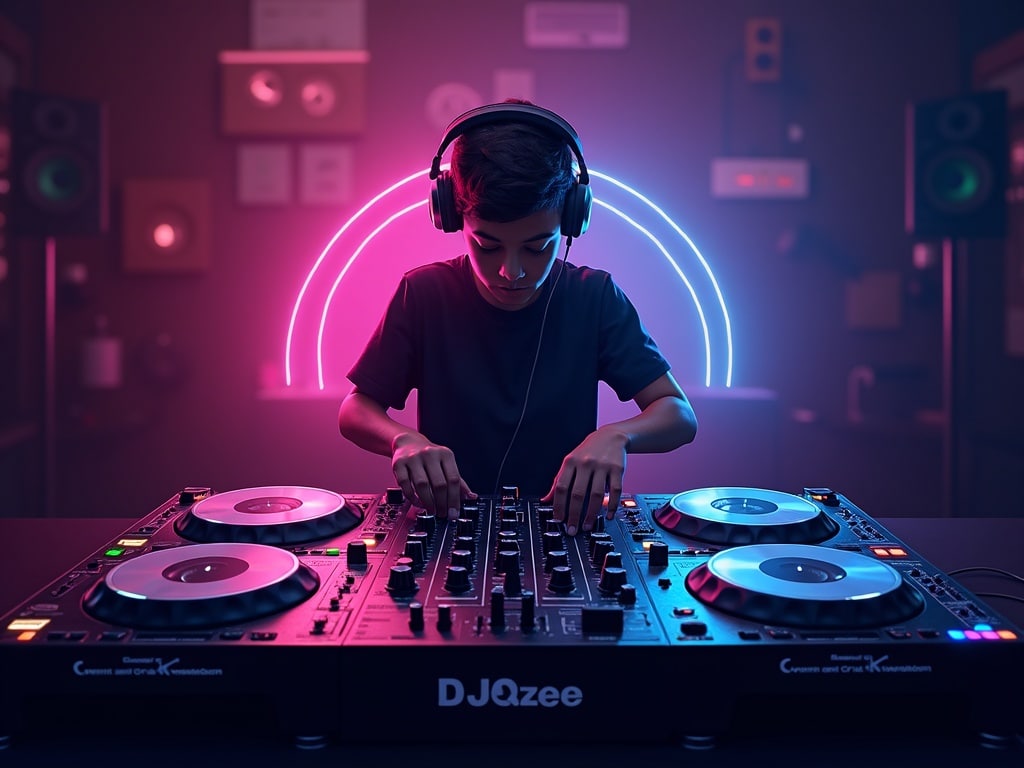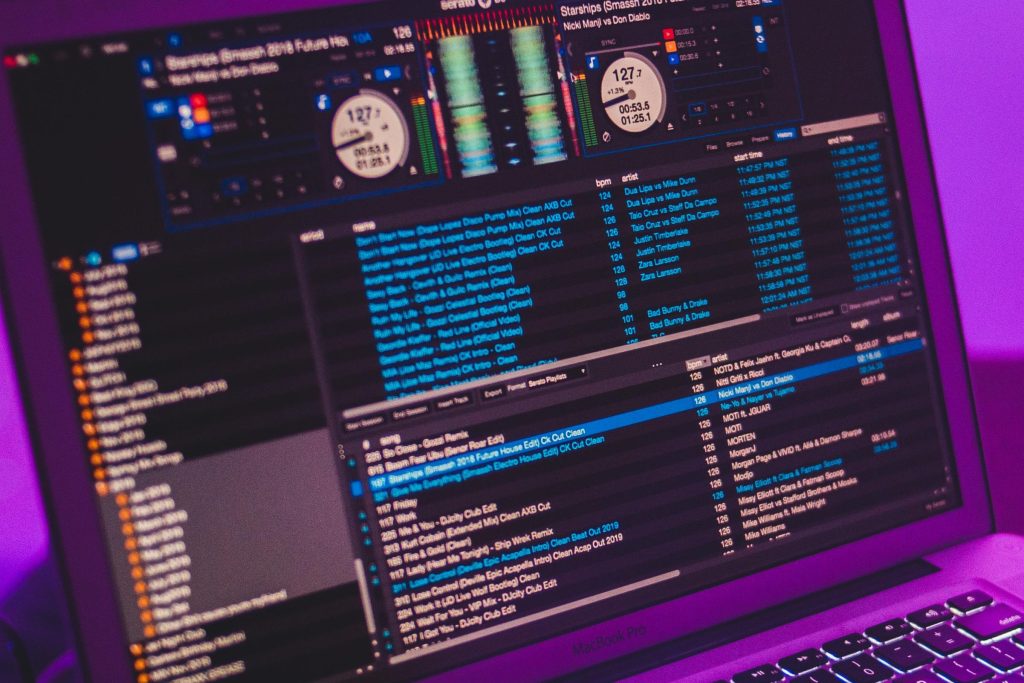DJing for Beginners: From Zero to Hero on the Decks!
What is DJing? More Than Just Playing Music
DJing is an art form. It's about crafting a unique sonic experience, blending tracks together seamlessly to create a vibe, a journey, a story. Forget just hitting 'play' – a DJ is a curator, a selector, a conductor of energy on the dance floor (or airwaves!). Think of it as musical alchemy.
There's a style of DJing out there for everyone. Let's scratch the surface (pun intended!) of the different worlds a DJ can explore.
- Club DJ: The lifeblood of nightlife. They command the energy of a packed dance floor, reading the crowd and delivering the perfect mix of house, techno, hip-hop, or whatever gets people moving.
- Mobile DJ: Party starters for hire! Weddings, birthdays, corporate events - mobile DJs bring the music to the people, adapting to a wide range of tastes and requests.
- Radio DJ: Broadcasting beats to the masses. Radio DJs blend music with personality, keeping listeners entertained and informed.
- Turntablist/Scratch DJ: These are the sonic acrobats! Mastering the art of manipulating records with turntables to create incredible soundscapes, scratches, and rhythms.
Essential DJ Equipment: Your Arsenal of Sound
Before you can conquer the clubs or airwaves, you'll need the right tools. Here's a breakdown of essential DJ equipment for beginners:
- Turntables (or Media Players): The heart of the DJ setup. Turntables play vinyl records, while media players (like CDJs) play digital music from USB drives or CDs. Nowadays, digital DJing with controllers is super popular (more on that later!).
- Mixer: The bridge between your music sources. The mixer lets you blend two or more audio signals together, control volume levels, EQ (tone), and apply effects.
- Headphones: Your secret weapon for beatmatching. Headphones allow you to listen to the next track and get it perfectly in sync with the playing track before the audience hears it.
- Speakers: To blast that beat to the world! You'll need powered speakers (with built-in amplifiers) that faithfully reproduce your mixes. For home practice, studio monitors are ideal. For parties and gigs you'll need PA (Public Address) speakers.
Understanding Music Structure: The DJ's Blueprint
All music, regardless of genre, has a structure. Understanding this structure is crucial for seamless mixing. Key concepts include:
- Beats: The fundamental pulse of the music. Tap your foot along – that's the beat!
- Bars: A group of beats, usually four in modern music, forming a rhythmic unit.
- Phrases: A group of bars that form a musical idea, often 8 or 16 bars long. DJs usually mix at the start of a phrase and end it also at the end of a phrase.
- Key: A system of functionally related chords deriving from the major and minor scales, with a common tonic (center or keynote).
Think of beats as individual bricks, bars as small walls, and phrases like rooms in a building. By understanding music like this, your mixes will sound deliberate, intentional, and AMAZING!
Beatmatching Techniques: Syncing the Sound
Beatmatching is the art of synchronizing the tempo (speed) of two songs so they play perfectly in time with each other. There are two main approaches:
- Manual Beatmatching: Using your ears and the turntable's pitch control to adjust the tempo of a track until it matches the playing track. This takes practice, but it's a fundamental DJ skill!
- Software-Assisted Beatmatching: Most DJ software (Serato DJ, Traktor, Rekordbox) have a sync button that automatically matches the tempos of tracks. A great starting point, but you should still learn manual beatmatching to develop your ear.
Basic Mixing Techniques: From Fades to Filters
Once your tracks are beatmatched, it's time to get creative with mixing! Here are some essential techniques:
- Fading: Smoothly transitioning from one track to another using the mixer's faders.
- EQing: Adjusting the frequencies (bass, mids, highs) of each track to create space and clarity in the mix. Reducing the bass of the incoming track as you bring it in is a general good approach.
- Using Filters: Adding sweeping effects to modulate and highlight certain frequencies, creating tension and release.
Experiment with these techniques to develop your own signature mixing style.
Choosing Your Music: Building a Sonic Palette
A DJ is only as good as their music collection. Building a diverse and engaging library is crucial. Consider these tips:
- Explore different genres: Don't limit yourself! Listen to a wide range of music to broaden your horizons and find hidden gems.
- Curate your collection: Be selective. Only include tracks that you truly love and that fit your DJ style.
- Organize your music: Tag your tracks with useful information like genre, energy level, and key for easy browsing.
Setting Up Your DJ Equipment: Connecting the Dots
Getting your DJ setup connected properly is essential for a smooth performance. Here's a basic guide:
- Connect your turntables/media players to the mixer's inputs.
- Connect the mixer's output to your speakers.
- Connect your headphones to the mixer's headphone jack.
- Adjust the gain levels on each channel to optimize the audio signal.
Refer to your equipment's manuals for specific instructions and diagrams.
Creating Your First Mix: A Step-by-Step Guide
Ready to put your skills to the test? Here's a step-by-step guide to creating your first mix:
- Choose two tracks that complement each other.
- Load one track onto each deck.
- Beatmatch the two tracks.
- Use the faders to smoothly transition from one track to the other.
- Experiment with EQing and filters.
- Record your mix (see section below!).
Don't be afraid to make mistakes - that's how you learn!
Practicing and Improving Your Skills: Repetition is Key
Like any skill, DJing takes practice. Here are some tips to accelerate your progress:
- Practice regularly: Set aside dedicated time to practice each day or week.
- Record your mixes: Listen back to your recordings and identify areas for improvement.
- Watch other DJs: Learn from the pros by watching their sets and analyzing their techniques.
- Challenge yourself: Try mixing different genres or using new techniques.
Where to Find Music for DJing: Stocking Your Arsenal
Building a DJ library can be expensive, but there are plenty of resources available:
- Record Pools: Subscription services that offer DJs access to a vast library of music for a monthly fee.
- Online Stores: Purchase individual tracks from online music stores like Beatport, Traxsource, and iTunes.
- Thrift Stores and Garage Sales: Dig for vinyl treasures at bargain prices.
- Bandcamp: A great place to support independent artists and discover unique music.
DJ Software Options: Digital DJing Made Easy
- Serato DJ: Widely used by professional DJs, known for its stability and intuitive interface.
- Traktor Pro: Native Instruments' flagship DJ software, offering advanced features and customization options.
- Rekordbox: Pioneer DJ's software, designed for seamless integration with their hardware.
Most DJ software offers a free trial period, so experiment to find the one that suits you best!
DJ Hardware Controllers: Your All-in-One Solution
DJ controllers combine the functionality of turntables and a mixer into a single unit, offering a streamlined and portable DJing experience. There are two main types:
- All-in-One Systems: Controllers that include everything you need to DJ, except for speakers and headphones.
- Modular Setups: Combine individual controllers, such as separate decks and mixers, to create a custom setup. This is typically more expensive, but better quality.
Controllers are a great option for beginner DJs, offering a cost-effective way to learn the ropes.
Understanding DJ Terminology: Speak the Language
Here's a glossary of common DJ terms:
- Beatmatching: Synchronizing the tempo of two tracks.
- Crossfader: The fader on the mixer that blends between two channels.
- EQ: Equalization, adjusting the frequencies of a track.
- Gain: Input volume level of a channel.
- Hot Cue: A saved point in a track that can be instantly recalled.
- Loop: Repeating a section of a track.
Familiarize yourself with these terms to communicate effectively with other DJs.
How to Record Your Mixes: Capture the Magic
Recording your mixes is essential for self-assessment and sharing your talent. Here are two methods:
- Software Recording: Most DJ software has a built-in recording feature.
- Hardware Recording: Use an external audio interface to record your mixer's output into a computer or recording device.
Once you've recorded your mix, you can share it on platforms like SoundCloud, Mixcloud, and YouTube.
Promoting Yourself as a DJ: Get Your Name Out There
Once you're confident in your skills, it's time to promote yourself! Here are some strategies:
- Online: Create a DJ website, promote your mixes on social media, and engage with your fans.
- Offline: Network with other DJs, attend local events, and offer your services to local businesses.
Building a reputation takes time and effort, so be patient and persistent.
DJing Ethics: Playing it Fair
Respect the music and the artists who create it. Adhere to copyright laws by purchasing your music legally or using licensed music services and always give credit to the original artists.
Common Mistakes to Avoid When Starting Out
- Playing tracks that are too different in style or energy.
- Overusing effects.
- Not practicing regularly.
- Being afraid to experiment.
Learn from your mistakes and keep pushing yourself to improve.
Advanced DJ Techniques: Level Up Your Skills
Once you've mastered the basics, explore advanced techniques like:
- Looping: Creating rhythmic variations by repeating sections of a track.
- Sampling: Incorporating short audio clips into your mixes.
- FX: Using a variety of effects to add texture and depth to your sound.
Experiment with these techniques to develop your own unique DJing style.
How to Read a Crowd: Connecting with Your Audience
A great DJ is more than just a technical wizard – they're also a crowd reader. Pay attention to the energy of the dance floor and select music that resonates with the audience. Adapt to their reactions and create a shared experience.
The Future of DJing: Technology and Trends
DJing is constantly evolving, with new technologies and trends emerging all the time. Keep an eye on developments in areas like:
- AI-powered DJing tools.
- Virtual reality DJing experiences.
- The rise of streaming and online DJing.
Embrace the future and continue to innovate to stay ahead of the curve.


